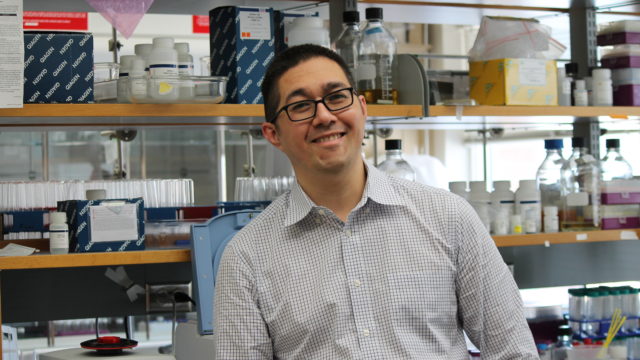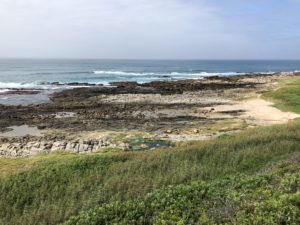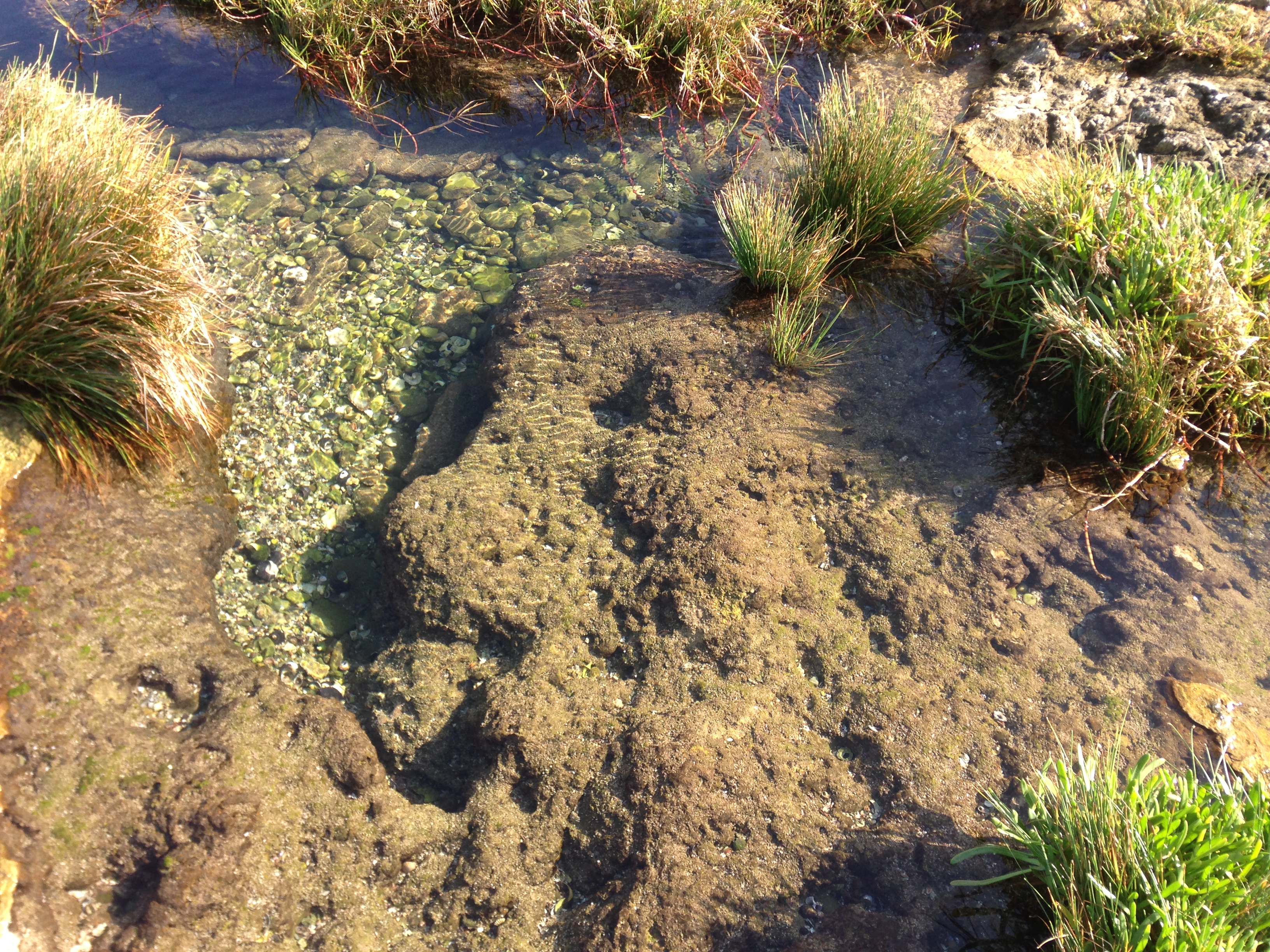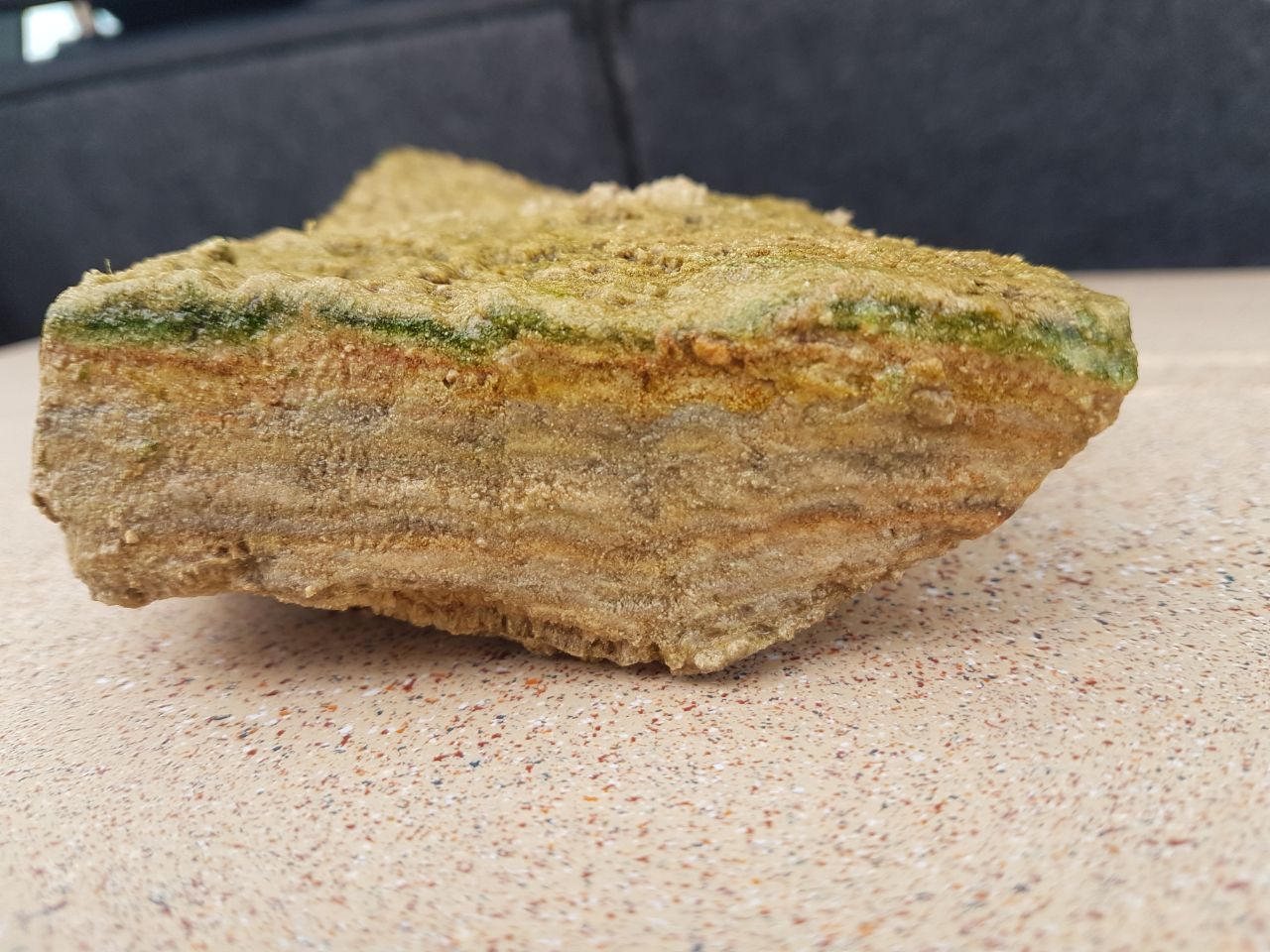
School of Pharmacy researchers seek stromatolites in South Africa for clues to therapeutic possibilities
By Jill Sakai
Along the southeastern coast of South Africa, groundwater seeping out of the dunes forms a series of small pools. They flow down the shore toward the sea, gradually mixing freshwater with saltwater from high tide. It’s a picturesque spot, certainly—but a sweeping glance doesn’t capture the remarkable biology underfoot. These pools hold an astounding diversity of complex, dynamic ecological communities engaged in a constant battle for survival among fierce competition for resources and against the harsh intertidal environment.
To the untrained observer, the pools appear lined with unremarkable rocks, fuzzy with a layer of green algae. But cutting into one of those fuzzy green rocks will reveal a layer cake of mineral deposits hued in yellows and ochres and pinks.
These living rocks are actually mineral deposits built by invisible architects—teeming communities of bacteria and other microscopic creatures. Called stromatolites, they are relics of an ancient Earth. Stromatolites were some of the first cellular communities to emerge from the early seas and released the oxygen that now defines the Earth’s atmosphere. Specimens dating back to about 3.5 billion years ago are the first fossil evidence of cellular life on a young planet.
“If you want to find interesting molecules, you should go somewhere with high biodiversity, where there is lots of competition—in other words, a lot of evolutionary pressure to produce chemical defenses.” –Jason Kwan
This is where Jason Kwan is looking for clues to what could become the newest tools in a pharmacist’s arsenal. As an assistant professor in the Pharmaceutical Sciences Division of the University of Wisconsin–Madison School of Pharmacy, Kwan explores the molecular strategies nature has developed to tackle common biological challenges, such as health, protection, and communication.
Small molecules, big pharmaceutical potential
Kwan’s focus is on small, biologically active molecules produced in nature, often termed natural products.
These small molecules are made by organisms—especially bacteria, fungi and plants—for a variety of purposes. Some are essentially chemical warfare intended to deter would-be predators or competitors. Others may protect the maker against disease. And their activity against biological targets—invading bacteria, for example—makes them interesting for potential pharmaceutical use as well, Kwan says. Many antibiotics, painkillers and cancer drugs, for example, are either derived from or based upon natural products.

“A lot of the drugs we have today are natural molecules,” Kwan explains. “These small molecules are the products of evolution. They’ve been shaped by natural selection over millions of years to act against some kind of biological target. And so when you want to try to find something that’s going to be active against some kind of therapeutic target, a good place to start is to look for new natural molecules.”
Some early examples were found by happenstance. Penicillin, for example, was first discovered on a contaminated lab plate and later isolated from a moldy cantaloupe. Modern searches are more deliberate, scouring diverse environments for molecules with promising activity.
“If you want to find interesting molecules, you should go somewhere with high biodiversity, where there is lots of competition—in other words, a lot of evolutionary pressure to produce chemical defenses,” Kwan says.
In recent decades, natural compounds have been found in soil, rainforests, and the oceans. Kwan is investigating natural products from marine sponges, simple blobby invertebrates that filter bits of food from seawater.
Although simple, sponges house vast communities of bacteria that compete for space in the relative safety of the animal’s channeled interior. By comparing different sponges, Kwan is learning what small molecules the microbial communities make and how they use them. Some likely help the community members communicate. Others may protect the community or the sponge itself against infection by invading bacteria.
In some sponges, Kwan has found molecules that block the formation of tough microbial sheets called biofilms. Anti-biofilm compounds have potential uses as diverse as sterilizing medical equipment and reducing algae growth on the hulls of ships.
With recent funding from the Gordon and Betty Moore Foundation, Kwan is now partnering with a large team of colleagues in South Africa and across the United States to apply a similar approach to the South African stromatolites. They will explore the unique ecology of these complex microbial communities and search for interesting new small molecules.
“There’s lots of interesting innovations that can be made from looking at how evolution has solved certain problems.” –Jason Kwan
“The South African stromatolites seem to be remarkably versatile in adapting to changing environments,” says Rosemary Dorrington, a professor of microbiology at Rhodes University in Grahamstown, South Africa. “They’ve evolved to adapt to extremes of environment.”
That ability makes the communities and their natural products of particular interest. “The whole project is looking at not only what molecules are there, but under what circumstances they are expressed and how this changes due to different environmental conditions in this South African stromatolite system,” Kwan says. That information will give clues as to what the molecules do, he explains.

But dissecting such a complex ecosystem is no simple task. A single stromatolite sample is a soup of DNA sequences from an unknown number of different species, along with a slew of small molecules. Teasing apart the mix takes many types of expertise, Kwan says. Dorrington’s group and a team at Oregon State University will sequence DNA from the stromatolites to learn what kinds of species are present. Researchers at the University of California San Diego will then identify what kinds of small molecules they are making.
To figure out how those molecules work, though, they need to know who’s making what. Such connections set the stage for understanding not only what the molecules do, but how they are made. Recreating those synthesis pathways in the lab is key to further explorations of how the molecules work—and how they might become useful for human applications.
This is where Kwan’s research group comes in.
Understanding genetics to inform therapeutics
“One of the things we’ve done in my lab is develop bioinformatics methods to reconstruct individual genomes from such a complex data set,” Kwan says. His computational tools piece together short microbial DNA fragments into longer bits that can be lined up and assembled into larger chunks. The longer stretches can be combined based on sequence characteristics, shared gene patterns and comparisons to databases of known organisms. His process uses machine learning—computer algorithms that can be trained to find patterns—to cluster the data into related groups.
Kwan’s group has worked with simulated mixtures containing as many as 2,000 different genomes, pushing their tools to the limit to see when they will break down. So far, Kwan says, his team can identify useful biological groupings from a mix of more than 1,000 different genomes with good accuracy.
Sam Waterworth, a new postdoctoral researcher in the Kwan Lab, cites that expertise in bioinformatics as a key factor in her decision to join the UW–Madison School of Pharmacy after finishing her graduate work with Dorrington in South Africa. “Bioinformatic tools that we feel are cutting-edge now will soon become routine,” she says. “To stay ahead in this field, one must have the ability to develop these tools. The capacity for this simply isn’t available back home.”
She will be building and using tools to curate, analyze, and interpret large datasets of sequences found in the stromatolite communities.
“In this project, we’ll be able to see patterns, like which species are always present in different stromatolites we sample,” Kwan says. “And with this total sequencing, we can see whether the genomes of a particular strain change or are mutated in different samples.”

That DNA-based knowledge provides a good foundation for exploring the community. But genes are just a cellular instruction manual, representing the potential for making or doing something. The researchers also want to know how the organisms are using those genes. For this, they look at the RNA sequences built from the DNA’s instructions.
These RNA sequences—together called the transcriptome—give insight into how the individual organisms function in the community and how they use their small molecules. The researchers can start to see who produces what, as well as when, how much and under what conditions. They can look at how patterns change, such as during the course of a day.
And, Kwan says, they’ll pay special attention to the biosynthetic pathways that make small molecules and see when and how they are active. Once the researchers understand what such molecules are doing in their natural environments, then they can start to think about possible uses in other contexts.
“There’s lots of interesting innovations that can be made from looking at how evolution has solved certain problems. A lot of the problems that bacteria have growing in a mixed environment are kind of similar to problems we have in terms of infection,” Kwan says.
“Of course, small molecules haven’t evolved to treat human diseases, they’ve evolved to increase the survival chance of whatever makes them,” he adds. “If we can understand more about why they’re made in the environment, that will help us think about potential therapeutic applications in a more targeted way.”
Learn more about the research in Dr. Kwan’s lab.